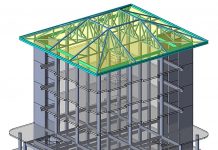In part 1 of a series of articles, NBS asks if you are BIM ready, and outline what your business needs to do before 2016
The UK Government has mandated that all centrally-funded work is to be undertaken using BIM by 2016. This is now less than 12 months away, and for those organisations that haven’t yet done so, this series of articles explains how to implement BIM in your organisation – and don’t worry, it’s not too late!
The process of implementing BIM is about change management, first and foremost. To do this successfully, the process needs to be carried out methodically. The best way is to make a ‘BIM implementation plan’, and the steps for this are outlined through the course of this series. Part 1 deals with the first step, which is to undertake an audit of your existing business.
Business audit – part 1
1. Establish your existing BIM maturity level
The Government mandate for next year is for BIM maturity Level 2, for centrally-funded work. The maturity levels up to and including Level 2 have been defined, although Level 3 is still to be finalised. However, most organisations that haven’t yet achieved Level 2 will probably already be complying with one of the lower levels; and of those who are already aware of the existence of maturity levels, 35% are currently only one step down at Level 1 (source: NBS National BIM Survey 2015).
Broadly speaking, Level 0 represents the use of CAD for 2D drafting only, and no collaboration between parties. Level 1, meanwhile, includes the use of 3D CAD for conceptual and presentation work, with data being shared electronically; often by the main contractor (this has in fact been increasing in popularity over the last five years or so). For Level 2, 3D CAD models are developed by each design team, sharing the information not simply as ‘prints’ (whether paper or electronic, such as PDF) but in the form of the CAD model itself, albeit exported to a common file format that can be read by other software applications. It is the common file format, together with the management and method of sharing the data, which underpins the definition of Level 2, and which requires more rigorous application and implementation of standardised working methods than may have been the case previously. Like Quality Assurance, BIM Level 2 is aimed at ensuring that information is produced and shared in a consistent and standardised manner.
Refer to BIM levels explained article on theNBS.com for more information.
2. Existing client base
Look at your existing client base. Are they public- or private-sector clients? Do they need to comply with the Government mandate? Do they want to comply anyway, for ‘best practices’ reasons? The Government mandate is in respect of ‘all public sector centrally procured construction projects’, so if the majority of your workload comes from healthcare or educational projects, for example, then BIM Level 2 compliance will almost certainly be unavoidable if you don’t want to lose established business relationships.
Aside from your clients, what about the contractor organisations that you most commonly work with? Larger contractors are more likely to require BIM collaboration, because their workloads may take in public-sector projects, even if yours doesn’t.
3. Nature of existing work
Review your existing workload, as well as past workload. Are any current projects, or clients, public sector-based? Have you completed any publicly-funded work in the past, where there’s a chance of repeat work? Or has your organisation only ever been involved in private-sector works?
Perhaps equally importantly, do you have reason to believe that BIM could benefit current (or planned) projects? Are there any past projects where, in hindsight, collaborative working could have improved the project outcomes? For example, were any profits reduced as a result of discrepancies between design team information; or could building operating costs have been reduced if thermal modelling had been able to be carried out at an early stage of the project?
4. Future work sector plans and ambitions
Looking forward, what are your plans or ambitions for the direction of your business? You should already have an up-to-date business plan which will answer this question. Do you want to maintain what you’re doing now, or move into other work areas? In the aftermath of the recession it could pay to follow the old adage that, spreading workload between different work sectors can help to reduce exposure to future downturns.
Do you want to expand, for example into the public sector, or even to cash in on international work? BIM is being talked about on a global scale, not just the UK, and foreign competitors are equally likely to be up-skilling.
5. Existing skills
Examine the skill sets of all of your existing staff. This may mean conducting a survey to pick up any training or qualifications obtained by staff since they joined your organisation. Do any of them have relevant skills, which could assist in implementing BIM practices, and possibly remove the need for outsourcing training? Have any of them expressed any specific interest in BIM? Enthusiasm can be a significant aid to implementing change to long-established working practices in an organisation.
BIM working isn’t just about software, and a range of skills will be required. Suitable skills could include:
• 3D CAD expertise;
• IT and networking knowledge;
• Data transfer, security, and sharing;
• An aptitude for teaching and encouraging others;
• Familiarity with standards, data management and protocols;
• Project management experience;
• Coordination and liaison skills;
• Financial and performance measurement/assessment.
Parts 1-4 of the series available at theNBS.com.
Useful links
• BIM Implementation – Progressing from BIM 3D to 7D
• NBS National BIM Survey 2015
NBS (National Building Specification)
Tel: 0345 456 9594
info@theNBS.com
















